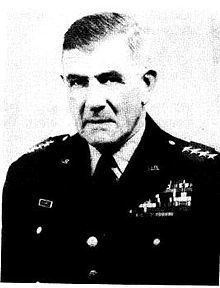Nickname(s) Bill Name William Hoge | Years of service 1916–1955 | |
 | ||
Born January 13, 1894Boonville, Missouri ( 1894-01-13 ) Allegiance United States of America Battles/wars World War IWorld War IIKorean War Awards Distinguished Service CrossDistinguished Service Medal(3)Silver Star (2)Legion of MeritBronze StarPurple HeartAir Medal People also search for Arthur W. Radford, Edward A. Craig, Joseph Stalin Commands held IX Corps, 4th Ard Division | ||
General William Morris Hoge (January 13, 1894 – October 29, 1979) was a United States Army officer who fought in World War I, World War II and the Korean War, with a military career spanning nearly forty years.
Contents
- Early life and military career
- Between the wars
- World War II
- Post World War II
- In popular culture
- References
Early life and military career
William M. Hoge grew up in Lexington, Missouri, where his father, William McGuffey Hoge, served as principal and superintendent at Wentworth Military Academy. After graduating from Wentworth in 1912, he received an appointment to the United States Military Academy (USMA) at West Point, New York. He graduated in 1916, then was commissioned into the Engineer Branch of the United States Army and commanded a company of the 7th Engineer Regiment at Fort Leavenworth, Kansas from 1917 to 1918.
During World War I, Hoge received the Distinguished Service Cross personally from General John J. Pershing, Commander-in-Chief (C-in-C) of the American Expeditionary Force (AEF) on the Western Front, for heroic action under fire as a battalion commander during the Meuse-Argonne Offensive.
Between the wars
During the interwar years, he graduated from the Massachusetts Institute of Technology and from the U.S. Army Command and General Staff School.
World War II
Hoge directed one of the great engineering feats of World War II, the construction of the 1,519-mile (2,450 km) ALCAN Highway in nine months. Later, in Europe, he commanded the Provisional Engineer Special Brigade Group in the assault on Omaha Beach. He then directed Combat Command B of the 9th Armored Division, in its heroic actions in the Ardennes during the Battle of the Bulge, and in its celebrated capture of the Ludendorff Bridge over the Rhine River at Remagen. By war's end, Hoge was the Commanding General of the 4th Armored Division.
Post World War II
During the Korean War, at the request of General Matthew Bunker Ridgway, the U.S. Eighth Army commander, Hoge commanded the IX Corps. Hoge achieved his senior command in the army as C-in-C of United States Army Europe. Hoge was promoted to major general in May 1945, lieutenant general in June 1951 and full general on October 23, 1953.
He retired from active duty in January 1955 to his hometown of Lexington, Missouri, then turned to the private sector as Chairman of the Board of Interlake Steel. Hoge moved to his son's farm in Kansas in October 1975 and he died suddenly on October 29, 1979 at Munson Army Hospital, Fort Leavenworth, Kansas.
In popular culture
In the 1969 film The Bridge at Remagen, the character of Brigadier General Shinner (played by E. G. Marshall) was based on Hoge.
Hoge Barracks, the transient housing operation at Fort Leavenworth, is named in his honor.
